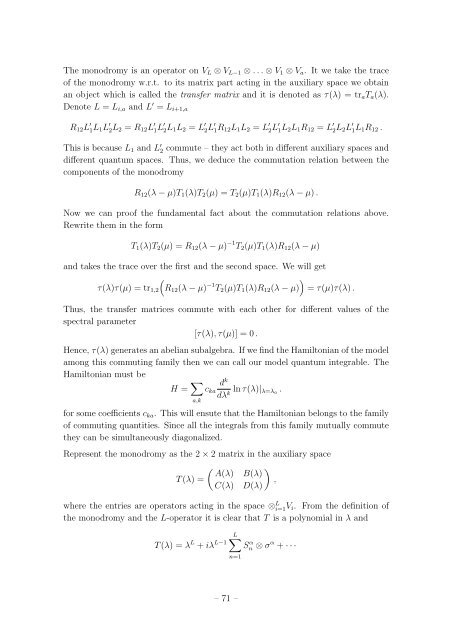Student Seminar: Classical and Quantum Integrable Systems
Student Seminar: Classical and Quantum Integrable Systems
Student Seminar: Classical and Quantum Integrable Systems
Create successful ePaper yourself
Turn your PDF publications into a flip-book with our unique Google optimized e-Paper software.
The monodromy is an operator on V L ⊗ V L−1 ⊗ . . . ⊗ V 1 ⊗ V a . It we take the trace<br />
of the monodromy w.r.t. to its matrix part acting in the auxiliary space we obtain<br />
an object which is called the transfer matrix <strong>and</strong> it is denoted as τ(λ) = tr a T a (λ).<br />
Denote L = L i,a <strong>and</strong> L ′ = L i+1,a<br />
R 12 L ′ 1L 1 L ′ 2L 2 = R 12 L ′ 1L ′ 2L 1 L 2 = L ′ 2L ′ 1R 12 L 1 L 2 = L ′ 2L ′ 1L 2 L 1 R 12 = L ′ 2L 2 L ′ 1L 1 R 12 .<br />
This is because L 1 <strong>and</strong> L ′ 2 commute – they act both in different auxiliary spaces <strong>and</strong><br />
different quantum spaces. Thus, we deduce the commutation relation between the<br />
components of the monodromy<br />
R 12 (λ − µ)T 1 (λ)T 2 (µ) = T 2 (µ)T 1 (λ)R 12 (λ − µ) .<br />
Now we can proof the fundamental fact about the commutation relations above.<br />
Rewrite them in the form<br />
T 1 (λ)T 2 (µ) = R 12 (λ − µ) −1 T 2 (µ)T 1 (λ)R 12 (λ − µ)<br />
<strong>and</strong> takes the trace over the first <strong>and</strong> the second space. We will get<br />
)<br />
τ(λ)τ(µ) = tr 1,2<br />
(R 12 (λ − µ) −1 T 2 (µ)T 1 (λ)R 12 (λ − µ) = τ(µ)τ(λ) .<br />
Thus, the transfer matrices commute with each other for different values of the<br />
spectral parameter<br />
[τ(λ), τ(µ)] = 0 .<br />
Hence, τ(λ) generates an abelian subalgebra. If we find the Hamiltonian of the model<br />
among this commuting family then we can call our model quantum integrable. The<br />
Hamiltonian must be<br />
H = ∑ d k<br />
c ka<br />
dλ ln τ(λ)| k λ=λ a<br />
.<br />
a,k<br />
for some coefficients c ka . This will ensute that the Hamiltonian belongs to the family<br />
of commuting quantities. Since all the integrals from this family mutually commute<br />
they can be simultaneously diagonalized.<br />
Represent the monodromy as the 2 × 2 matrix in the auxiliary space<br />
( )<br />
A(λ) B(λ)<br />
T (λ) =<br />
,<br />
C(λ) D(λ)<br />
where the entries are operators acting in the space ⊗ L i=1V i . From the definition of<br />
the monodromy <strong>and</strong> the L-operator it is clear that T is a polynomial in λ <strong>and</strong><br />
T (λ) = λ L + iλ L−1<br />
L<br />
∑<br />
n=1<br />
S α n ⊗ σ α + · · ·<br />
– 71 –

















